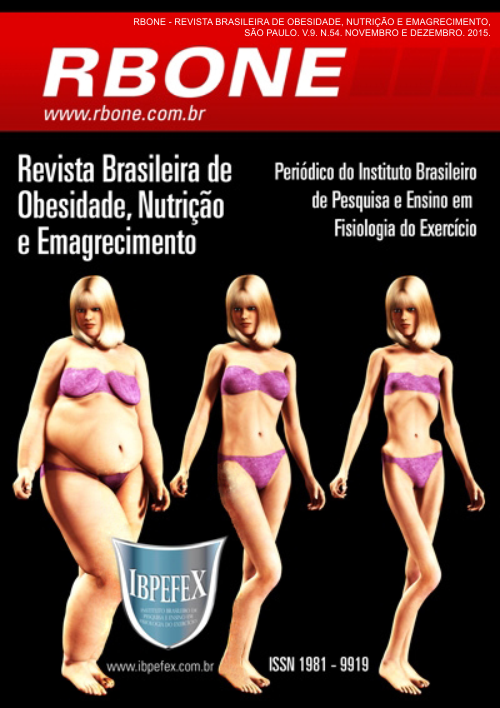Concentration of serum evaluation resistin in obese young adults: a cross study
Abstract
Resistinis a protein produced by adipocytes and macrophages is associated with the development of insulin resistance (IR) and T2DM, and has been demonstrated that this protein is an antagonist of insulin. The objective of this study was to evaluate serum resistin, glucose, HbA1c, insulin in young adults, obese, overweight and normal weight. A cross-sectional study comparing baseline levels of resistin and biochemical parameters were evaluated. 149 young adults were involved in this study, 54 normal weight (18 to 24.9 kg/m2), 27 overweight (25-29.9 kg/m2) and 68 obese (BMI ≥ 30 kg/m2). Obese patients showed resistinlevels, glucose, HbA1c, insulin, and HOMA significantly higher when compared with normal weight patients, and showed significantly reduced insulin sensitivity. Increased production of resistin in obese young adults may be a major factor in the developmentof the inflammatory process and hence RI and DM2 in this population. However, you need larger studies to clarify the exact mechanisms of action of this adipokine in the obese population.
References
-Buse, M. G. Hexosamines, insulin resistance, and the complications of diabetes: current status. Am.J. Physiol. Endocrinol. Metab. Vol. 290. Núm. 1. p. E1-E8. 2006.
-Carvalheira, J. B. C.; Zecchin, H. G.; Saad, M. J. A. Vias de sinalização da insulina. Arquivo Brasileiro de Endocrinologia e Metabologia. Vol. 46. Núm. 4. p. 419-425. 2002.
-Greenberg, A. S.; McDanieL, M. L. Identifying the links between obesity, insulin resistance and β-cell function: potential role of adipocyte-derived cytokines in the pathogenesis of type2 diabetes. European Journal of Clinical Investigation. Vol. 32. p. 24-34. 2002.
-Hall, J. E.; Guyton, A. C. Balanços Dietéticos; Regulação de Alimentação; Obesidade e Inanição; Vitaminas e Minerais. In: (Org.). Tratado de fisiologia médica. Rio de Janeiro. Elsevier. p. 887-904. 2011.
-Hodge, A. M.; Zimmet, P. Z. The epidemiology of obesity. Baillière’s Clinical Endocrinology and Metabolism. Vol. 8. Núm. 3. p. 577-99. 1994.
-Hoehn, K. L.; Salmaon, A. B.; Hohnen-Behrens, C.; Turner, N. Hoy, A. J.; Maghzal, G. J.; Stocker, R.; Van Remmen, H. Kraegen, E. W.; Cooney, G. J. Richardson, A. R. James, D. E. Insulin resistance is a cellular antioxidant defense mechanism. Proc. Natl. Acad. Sci. USA. Vol. 106. Núm. 42. p. 17787-92. 2009.
-Kahn, S. E.; Hull, R. L.; Utzschneider, K. M.; Mechanisms linking obesity to insulin resistance and type 2 diabetes. Nature. Vol. 444. p. 840-6. 2006.
-KuminskI, C. M.; McTernan, P. G.; Kumar, S. Role of resistin in obesity, insulin resistance and Type II diabetes. Clinical Science. Núm. 109. p. 243-256. 2005.
-McTernan, CL.; e colaboradores. Resistin, central obesity, and type 2 diabetes. The Lancet. Vol. 359. p. 46-47. 2002.
-Santos, H. S.; e colaboradores. Oral Angiotensin-(1-7) prevented obesity and hepatic inflammation by inhibition of resistin/TLR4/MAPK/NF-кB in rats fed with high-fat diet. Elsevier. Peptides. p. 47-52. 2013.
-Silveira, M.R.; Frollini, A.B.; Verlengia, R.; Cavaglieri, C.R. Correlação entre obesidade, adipocinas e sistema imunológico. Rev Bras Cineantropom Desempenho Hum. Vol. 11. Núm. 4. p. 466-472. 2009.
-Sinha, R.; Fisch, G.; Teague, B.; Tamborlane, W. V.; Banyas, B.; Allen, K.; Savoye, M.; Rieger, V.; Taksali, S.; Barbetta, G.; Sherwin, R. S.; Caprio, S. Prevalence of impaired glucose tolerance among children and adolescents with marked obesity. The New England Journal of Medicine. Vol. 346. Núm. 11. p. 802-810. 2002.
-Shulman, G.I. Cellular mechanisms of insulin resistence. J Clin Invest. Vol. 106. Núm. 2. p. 171-176. 2000.
-Steppan, C. M.; e colaboradores. The hormone resistin links obesity to diabetes. Nature. Núm. 409. p. 307-112. 2001.
-Virkamäki, A.; Korsheninnikova, E.; Seppälä-Lindroos, A.; Vehkavaara, S.; Goto, T.; Halavaara, J.; Häkkinen, A. M.; Yki-Järvinen, H. Intramyocellulkar lipid is associated with resistance to in vivo insulin actions on glucose uptake, antilipolysis, ans early insulin signaling pathways in human skeletal muscle. Diabetes. Vol. 50. p. 2337-2343. 2001.
-Weiner, J.S.; Lourie, J.A. Practical Human Biology.London.Academic Press.1981.
Authors who publish in this journal agree to the following terms:
- Authors retain the copyright and grant the journal the right of first publication, with work simultaneously licensed under the Creative Commons Attribution License BY-NC which allows the sharing of the work with acknowledgment of the authorship of the work and initial publication in this journal.
- Authors are authorized to enter into additional contracts separately for non-exclusive distribution of the version of the work published in this journal (eg, publishing in institutional repository or book chapter), with acknowledgment of authorship and initial publication in this journal.
- Authors are allowed and encouraged to post and distribute their work online (eg, in institutional repositories or on their personal page) at any point before or during the editorial process, as this can bring about productive change as well as increase impact and impact. citation of published work (See The Effect of Free Access).






